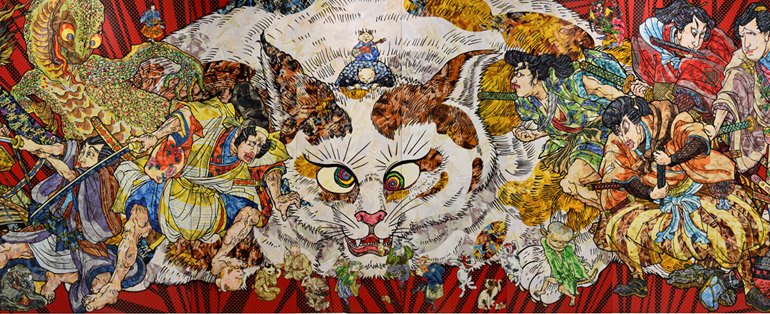Japan Supernatural
Art Gallery of New South Wales
Sydney, Australia
Some claim that “supernatural” is in essence a null word as in that one man’s magic is another man’s engineering. Now, while there might be not unlike with many sayings a shrapnel of truth to it, there has certainly never been anything primitive about Japanese art: The meticulously sophisticated approach of Japanese artists to their respective crafts is undisputed and in terms of “engineering” it does not get much more imaginative than what the Art Gallery of New South Wales has curated under the moniker Japan Supernatural.
Centred around Takashi Murakami’s monumental 25 metre In the Land of the Dead, Stepping on the Tail of a Rainbow, the works of the exhibition cover three centuries of Japanese art, comprised of paintings, sculptures, prints, paper lanterns and interactive touch walls, exploring the realms beyond nature and what has been attributed to being the creation of forces beyond that which humans are equipped with.
Highlights of the exhibition include the Japanese contemporary equivalent to Grimm’s tales, i.e. Miwa Yanagi’s twisted fairy-tales and Fuyuko Matsui’s elegant yet macabre depictions of death and decay, which are the nuances that throne above the backbone of older works that revolve around “yokai”, i.e. demons, ghouls, trolls or monsters. What never ceases to astonish and what I particularly enjoyed about Japan Supernatural is that one gets to closely examine the advanced printing techniques, which add depth and along with the non-traditional composition and perspective create a total that is much bigger than the sum of its individual components.
While it does not prove difficult to detect often obvious parallels to the depiction of paranormal phenomena known in Western cultures, the idiosyncratic Japanese approach to visualising the unseen infused by local folklore, superstition and the underlying belief that every thing is inhabit by a soul, adds a dimension that creates a sense of wonder – a sense of wonder that if one visits Japan, can still be felt and which counterbalances the conformity that informs all facets of the ever efficient Japanese society and which contemporarily can be found manifest in manga and anime.
In a subtle manner a red thread connects works from the Edo period via the classical dance drama of Kabuki to demonic incarnations of the present time and creates a cohesive whole that illustrates the high-value curation that continues to make AGNSW’s exhibitions dense, interesting and in this case, shows forces that make things very different to what we think they are, which in essence is one of the reasons I visit a museum.

---
Image from exhibit website